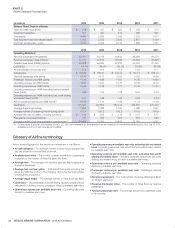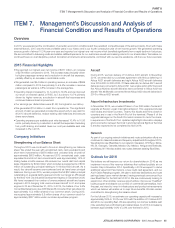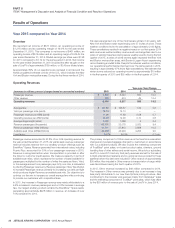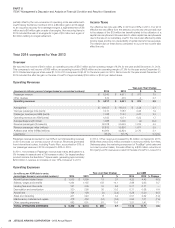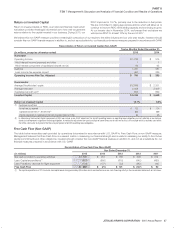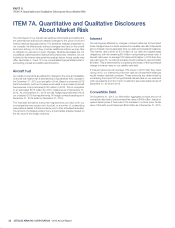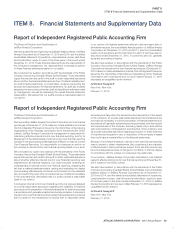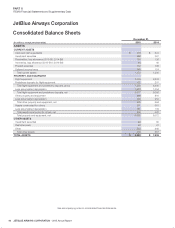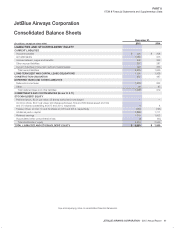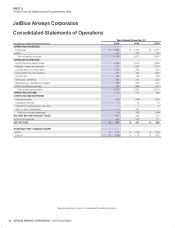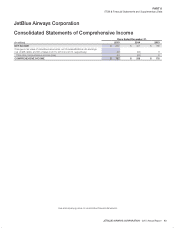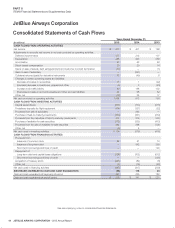JetBlue Airlines 2015 Annual Report Download - page 38
Download and view the complete annual report
Please find page 38 of the 2015 JetBlue Airlines annual report below. You can navigate through the pages in the report by either clicking on the pages listed below, or by using the keyword search tool below to find specific information within the annual report.
JETBLUE AIRWAYS CORPORATION-2015Annual Report34
PART II
ITEM7Management’s Discussion and Analysis of Financial Condition and Results of Operations
Committed expenditures for our firm aircraft and spare engines include
estimated amounts for contractual price escalations and predelivery
deposits. We expect to meet our predelivery deposit requirements for
our aircraft by paying cash or by using short-term borrowing facilities
for deposits generally required sixto 24months prior to delivery. Any
predelivery deposits paid by the issuance of notes are fully repaid at the
time of delivery of the related aircraft.
Our Terminal at JFK, T5, is governed by a lease agreement we entered
into with the PANYNJ in 2005. We are responsible for making various
payments under the lease. This includes ground rents for the terminal
site which began at the time of the lease execution in 2005 and facility
rents commenced in October 2008 upon our occupancy of T5. The
facility rents are based on the number of passengers enplaned out of
the terminal, subject to annual minimums. The PANYNJ reimbursed us
for construction costs of this project in accordance with the terms of the
lease, except for approximately $76 million in leasehold improvements
provided by us. In 2013, we amended this lease to include additional
ground space for our international arrivals facility, T5i, which we opened in
November 2014. For financial reporting purposes, the T5 project is being
accounted for as a financing obligation, with the constructed asset and
related liability being reflected on our consolidated balance sheets. The
T5i project was accounted for at cost. Minimum ground and facility rents
at JFK totaling $314 million are included in the commitments table above
as lease commitments and financing obligations.
We enter into individual employment agreements with each of our non-
unionized FAA-licensed Crewmembers, inspectors and air traffic controllers.
Each employment agreement is for a term of five years and automatically
renews for an additional five-year term unless the Crewmember is terminated
for cause or the Crewmember elects not to renew it. Pursuant to these
agreements, these Crewmembers can only be terminated for cause. In
the event of a downturn in our business requiring a reduction in flying
and related work hours, we are obligated to pay these Crewmembers a
guaranteed level of income and to continue their benefits. As we are not
currently obligated to pay this guaranteed income and benefits, no amounts
related to these guarantees are included in the contractual obligations
table above. Our pilots voted to be represented by ALPA during 2014.
Off-Balance Sheet Arrangements
None of our operating lease obligations are reflected on our consolidated
balance sheets. Although some of our aircraft lease arrangements are
with variable interest entities, as defined by the Consolidations topic
of the Codification, none of them require consolidation in our financial
statements. The decision to finance these aircraft through operating leases
rather than through debt was based on an analysis of the cash flows and
tax consequences of each financing alternative and a consideration of
liquidity implications. We are responsible for all maintenance, insurance and
other costs associated with operating these aircraft. However, we are not
obligated to provide any residual value or other guarantees to our lessors.
We have determined that we hold a variable interest in, but are not the
primary beneficiary of, certain pass-through trusts. The beneficiaries of
these pass-through trusts are the purchasers of equipment notes issued
by us to finance the acquisition of aircraft. Each trust maintains a liquidity
facility whereby a third party agrees to make payments sufficient to pay
up to 18months of interest on the applicable certificates if a payment
default occurs.
We have also made certain guarantees and indemnities to other unrelated
parties that are not reflected on our consolidated balance sheets, which
we believe will not have a significant impact on our results of operations,
financial condition or cash flows. We have no other off-balance sheet
arrangements. See Notes 2, 3 and 11 to our consolidated financial
statements for a more detailed discussion of our variable interests and
other contingencies, including guarantees and indemnities.
Critical Accounting Policies and Estimates
The preparation of our consolidated financial statements in conformity
with U.S. GAAP requires management to adopt accounting policies as
well as make estimates and judgments to develop amounts reported
in our financial statements and accompanying notes. We maintain a
thorough process to review the application of our accounting policies
and to evaluate the appropriateness of the estimates that are required to
prepare our financial statements. We believe our estimates and judgments
are reasonable; however, actual results and the timing of recognition of
such amounts could differ from those estimates. In addition, estimates
routinely require adjustment based on changing circumstances and the
receipt of new or better information.
Critical accounting policies and estimates are defined as those that are
reflective of significant judgments and uncertainties that could potentially
result in materially different results under different assumptions and
conditions. The policies and estimates discussed below have been reviewed
with our independent registered public accounting firm and with the Audit
Committee of our Board of Directors. For a discussion of these and other
accounting policies, see Note1 to our consolidated financial statements.
Passenger revenue
Passenger ticket sales are initially deferred in air traffic liability. Revenue is
recognized when transportation is provided or when a ticket or customer
credit expires. Air traffic liability also includes customer credits issued and
unused tickets whose travel date has passed. Credit for unused tickets
and customer credits can each be applied towards another ticket within 12
months of the original scheduled service or 12 months from the issuance
of the customer credit. We also defer in the air traffic liability account an
estimate for customer credits issued in conjunction with the JetBlue Airways
Customer Bill of Rights that we expect to be ultimately redeemed. These
estimates are based on historical experience and are periodically evaluated,
and adjusted if necessary, based on actual credit usage.
Frequent flyer accounting
We utilize a number of estimates in accounting for our TrueBlue
®
customer
loyalty program, or TrueBlue®. We record a liability for the estimated
incremental cost of outstanding points earned from JetBlue purchases that


